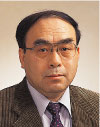|
|
 |
|
|
Shape Modeling Laboratory |

Daming Wei
Professor |

Alexander Belyaev
Associate Professor |
|
In AY 2001, the research in the shape modeling laboratory was focused on the following directions:
- Biomedical modeling and computer simulation
- Geometric modeling and processing
- Application of computer and information technology
3D visualization functions including 3D animation of propagation of excitation, heartbeat, and 3D model-editor facility are added to the state-of-the-art heart model and computer simulation system. This is a three-year project supported JapanSharyou ZaidanFoundation. Thedevelopment of a homecare service support system is another project of Prof. Wei, funded by the university competitive budget and the Japan Science and Technology Corporation (JST) Regional Science Program. The project is expected to make a direct contribution to the domestic society. Prof. Wei has a Japanese patent filed this year, relating to a technique that effectively removing the Muscle noise in recording the 12-lead electrocardiogram (ECG) with little distortion in signal components.
Prof. Belyaev has conduced fruitful results in his study on geometric modeling that includes:
- Developing new methods for accurate polygonization of isosurfaces with sharp features;
- Developing an image processing approach to stable detection of perceptually salient curvature extrema on triangulated surfaces;
- Discovering and studying new methods for shape and image denoising coupled with feature enhancement and mesh regularization;
- Developing new approaches for shape simplification with simultaneous preservation of perceptually salient shape features.
A Ph.D student studied at the Shape Modeling Lab, Mr. Yutaka Ohtake, was graduated in this academic year. He won his Ph.D from you University of Aizu with highest achievements. His dissertation is entitled "Mesh Optimization and Feature Extraction".
|
| [belyaev-001:2001] | Y. Ohtake and A. G. Belyaev. Mesh Optimization for Polygonized Isosurfaces. Computer Graphics Forum, 20(3):368-376, September 2001.
Eurographics 2001 issue |
| [belyaev-002:2001] | K. Watanabe and A. G. Belyaev. Detection of Salient Curvature Features on Polygonal Surfaces. Computer Graphics Forum, 20(3):385-392, September 2001.
Eurographics 2001 issue |
| [belyaev-003:2001] | Y.Ohtake, A. G. Belyaev, and I. A. Bogaevski. Mesh Regularization and Adaptive Smoothing. Computer-Aided Design, 33(11):789-800, September 2001.
CAD Special Issue on Geometric Modeling and Processing |
| [dm-wei-001:2001] | D. Wei. Laplacian Electrocardiograms Simulated Using Realistically shaped heart-Torso Model During Normal and Abnormal Ventricular Depolarization. Electromagnetics, 21:593-605, 2001.
This paper presents simulation studies of Laplacian electrocardiograms using a realistically shaped heart-torso model. Body surface Laplacian maps (BSLMs) during normal excitation and abnormal excitation with the Wolff-Parkinson-White syndrome are examined in comparison with the body surface potential maps (BSPMS). It shows that the BSLM can distinguish the left ventricular breakthrough with a special pattern, which is not distinguished with BSPM. It also shows that the BSLM has better specificity in discriminating multiple accessory pathways than the BSPM. These simulations theatrically suggest the advantages of Laplacian electrocardiogram as a non-invasive method in exploring the excitation processes of the heart. |
| [dm-wei-002:2001] | D. Wei and K Akashi. Derived 12-lead electrocardiogram and its application in pre-hospital care. The Japanese Journal of Acute Medicine, 26(3):359-362, 2002.
This paper describes the method, principle and experiment of derived 12-lead electrocardiogram and discusses its application (in Japanese) |
| [dm-wei-003:2001] | D.Wei. A Homecare Service Support System Using the Mobile Internet and Java Technology. Journal of Shanghai University (English Edition), 5,Suppl.(Sept.2001):177-180, 2001.
This paper presents a homecare service support system developed using Java technology. Through the mobile Internet, the system is aimed at real-time data sharing, real-time service management, and e-service for the customers. With a mobile PC or a personal digital assistant (PDA) that rungs a web browser, the homecare service is capable of real time communicate with a server at a medical center. Because of the high pace in model change in hardware of mobile PCandPDA, the system is integrated so that the mobile clients are hardware-independent and platform-independent using Java technology, such as the Java Servlet, the JavaServe page, and other Java APIs. |
| Referred Proceeding Papers |
| [dm-wei-004:2001] | D. Wei. Deriving the 12-lead Electrocardiogram From Four Standard Leads Based on the Frank Torso Model. In 23rd Annual International Conference of the IEEE Engineering in Medicine and Biology Society, Istanbul, Turkey., 25-28 October 2001.
A method that derive 12-lead ECG from four standard leads. Heart vectors are obtained fromFrankimage surface. methodandevaluation are presented. |
| [dm-wei-005:2001] | D. Wei. A windows program for whole-heart modeling and electrocardiogaraphic computer simulation. In Symposium on In Siloco Technology in Pharmaceutical Research and Development, page 66, Kobe Japan., 22-24 April 2001.
A whole heart model and anECGsimulation system developed in a windows environment, used for studies from cellular action potential to body surface electrocardiogram |
| [dm-wei-006:2001] | D. Wei, K. Akashi, and T. Nanke. Derived 12-lead Electrocardiogram for clinical monitoring. In Japanese Journal of Clinical Monitoring, page 36, 18-19 May 2001.
A new method is proposed to monitor 12-lead ECG via four channel ECG recordings. This isexpected tobe appliedtoambulatorymonitoringin clinical practice, such as emergency medicine, bedside monitoring and so on. |
| [dm-wei-007:2001] | T. Nanke, S. Noda, K. Akashi, and D.Wei. EEG transmission of Derived 12-lead Electrocardiogram for Pre-hospital care of Ischemia for clinical monitoring. In Japanese Journal of Clinical Monitoring, page 21, 18-19 May 2001.
An experimental study in an ambulance is reported to show the feasibility using derived 12-lead ECG (in Japanese) |
| [dm-wei-008:2001] | D.Wei, K.Akashi, andT.Nanke. Aproposal of Derived 12-lead Electrocardiogram for clinical telemetry. In Proceedings of 40th Annual Conference of Japanese society of Biomedical Engineering, page 377. Japanese Journal of Medical Electronics and Biological Engineering, 9-11 May 2001.
A proposal of derived 12-lead ECG system and method for deriving 12-lead ECG. An experimental study using mobile teletransmission is reported (in Japanese). |
| [belyaev-006:2001] | Y. Ohtake, A. G. Belyaev, and A. Pasko. Dynamic meshes for accurate polygonization of implicit surfaces withsharp features. In Shape Modeling International 2001, pages 74-81, Genova, Italy, May 2001. |
| [belyaev-007:2001] | A. G. Belyaev and S. Yoshizawa. OnEvolute Cusps and Skeleton Bifurcations. In Shape Modeling International 2001, pages 74-81, Genova, Italy, May 2001. |
| [belyaev-008:2001] | Y. Ohtake and A. G. Belyaev. Nonlinear Diffusion of Normals for Crease Enhancement. In Vision Geometry X, SPIE Annual Meeting, pages 74-81, San Diego, USA, July-August 2001. |
| [belyaev-009:2001] | Y.Ohtake, M.Horikawa, andA.G.Belyaev. Adaptive Smoothing Tangential Direction Fields on Polygonal Surfaces. In Pacific Graphics 2001, pages 189{197, Tokyo, Japan, October 2001. |
| [belyaev-010:2001] | M. Hisada, A. G. Belyaev, and T. L. Kunii. Adaptive Smoothing Tangential Direction Fields on Polygonal Surfaces. In Pacific Graphics 2001, pages 189{197, Tokyo, Japan, October 2001. |
| [dm-wei-009:2001] | Daming Wei and Zhongzhen Zhao, August 7-10 2001. Invited speech, The 6th Asian Conference on Analysis Sciences: A Study Toward the Computer-added examination of Traditional Chinese Patent Medicine Based on Microscopic Images |
| [dm-wei-010:2001] | D.Wei, E. Harasawa, and H. Harada. Noise reduction method and apparatus, 6 2001. |
|